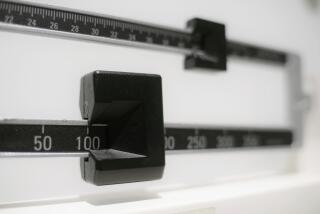Exercise Can Be Key to Waisting Away
- Share via
BALTIMORE — It’s almost time to stuff your winter body into a summer swim suit, and you’re starting to worry: When you hit the beach, will you be mistaken for a beached whale?
But there is no reason to panic. You still have time to lose that “extra 10” that latched onto you last winter and get in shape for The Season Without Sweat Suits.
There are, alas, no miracle methods. According to Dr. Lawrence Cheskin, director of a new obesity-treatment program at Baltimore’s Francis Scott Key Medical Center, the old rule still applies: “Eat less and exercise more.”
Traditionally, the “eat less” end of that equation has been the waist-watcher’s First Commandment. But today, weight control experts are stressing exercise, too.
“Eat less” works, of course, at least in the beginning. Whether we’re on high proteins, low carbohydrates, all fruits or mostly rice, we can trim down, because no matter what kind of diet it is, it restricts calories.
But most of us find that the pot at the end of that particular rainbow usually reappears where we least want it.
“Your body is a logical machine, designed to keep you alive,” explains Gina Greenley, exercise physiologist and on-site manager of a new health and fitness center for Francis Scott Key employees.
“When you go on any kind of calorie-reduced protocol, your body will slow down the furnace to conserve what little energy you’re giving it. When you diet, you’re training your body to operate with less food.”
Then when you return to normal eating--not even over-eating-- your sluggish furnace does not need the calories any more. Your body puts them into storage. Around your waist. On your thighs. In places where you hate to have it all hang out when summer comes and baggies go.
“Exercise,” Greenley declares, “counteracts that process.”
Logic (and physics) is on her side: Obviously, activity requires more energy than inactivity does. Because oxygen feeds the internal fire, the most effective calorie-burning activity is the steady, rhythmic, breathe-as-you-go, aerobic kind that keeps the heart healthy, too.
But there is a difference: You can keep your cardiovascular system in shape with 20 to 30 minutes of aerobic exercise three times a week. Depending on your body weight and the intensity of your activity, you can burn 200 to 300 calories in 20 minutes of jogging. But 3,500 calories are packed into each pound of fat. A quick jog just barely takes the edge off. For weight loss, therefore, you should “choose the exercise you enjoy enough to do on a regular basis, something you can sustain for a long period of time,” advises Ben Hurley, associate professor of exercise physiology and director of the exercise physiology lab at the University of Maryland College Park. “For weight control, I recommend that you try to sustain it for a minimum of 30 minutes, and preferably up to 60.”
As an adjunct to aerobics, Greenley advises weight training, aimed at muscle development.
“Muscle tissue has a more extensive biochemical and circulatory network, thus requiring more energy to maintain itself,” she explains. Fat, on the other hand, just sort of sits there, holding onto itself.
Muscle, moreover, is tighter than fat: It weighs more but takes up less room. It hugs the skeleton, Greenley says, so you look slimmer, whether you lose weight or not. She is her own best example: 5-foot-4, 140 pounds and, she says, a Size 4 dress.
